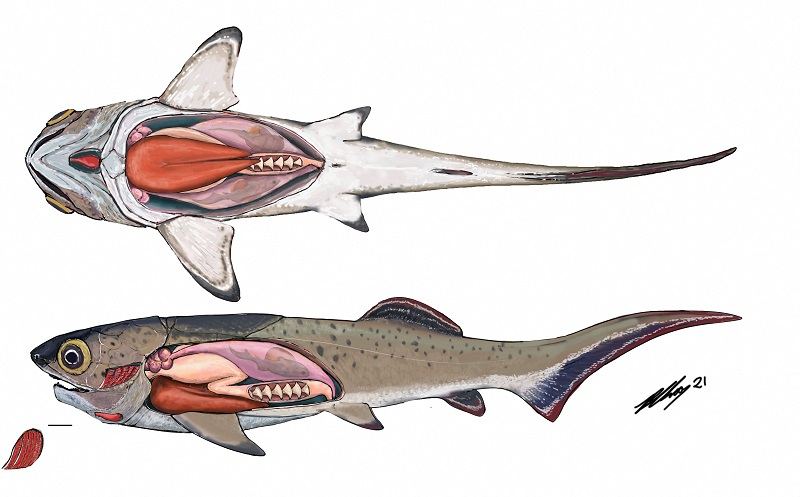
The internal organs of an ancient placoderm armored fish, called an arthrodire, that lived 380 million years ago are seen in this undated artist’s reconstruction including the heart, liver, stomach and intestine.
11:47 JST, September 25, 2022
Scientists in Australia have unearthed beautifully preserved fossilized hearts and other internal organs of ancient armored fish in a discovery that provides insight into the evolution of the bodies of vertebrates — including humans.
The researchers on Sept. 15 described the heart, the organ that pumps blood through the body’s circulatory system, in fish called placoderms that inhabited a tropical reef about 380 million years ago during the Devonian Period. The fossils were 250 million years older than any previously known fish heart.
The fossilized liver, stomach and intestine from these placoderms helped give a fuller view of the internal anatomy at a pivotal time in the history of vertebrates — backboned animals including fish, amphibians, reptiles, birds and mammals.
The fossils were found in a locale called the Gogo Formation in Western Australia’s Kimberley region near the town of Fitzroy Crossing. They are remarkable because soft tissue, unlike hard stuff such as bones and teeth, is rarely preserved as fossils and even less often preserved in a robust three dimensions, as these are, rather than flattened.
“The site is without a doubt one of the world’s most important fossil sites for understanding the early evolution of backboned animals, including the origins of the human body plan,” said vertebrate paleontologist Kate Trinajstic of Curtin University and the Western Australian Museum, lead author of the study published in the journal Science.
Placoderms, known for bony armor on the head and neck, represented “our earliest jawed ancestors,” Trinajstic said.
The newly described fossils are of two species, named Compagopiscis croucheri and Incisoscutum ritchiei, both about 25 centimeters long with shark-like asymmetrical tail fins, jaws bearing teeth and blade-like cutting edges, and broad, blunt-nosed heads.
The placoderms had an S-shaped heart similar to that of a shark. It was made up of two chambers, with a smaller one on top and a larger one underneath, and was located at the front of the shoulder girdle in a similar position to sharks and bony fish today. Its structure differs from later vertebrates. Amphibians and reptiles have a three-chambered heart, while mammals and birds have a four-chambered heart.
In land vertebrates, which evolved from fish during the Devonian, the heart has moved further back along the body — or down from the perspective of upright humans. If a person’s heart was in the same place as these placoderms, it would be at the base of the throat between the collar bones.
The placoderm liver was large and enabled the fish to remain buoyant, as in sharks. The liver showed how placoderms had evolved away from the organ arrangement of jawless fish. In jawless fish called lampreys, the liver is squashed against the heart and envelops it from behind. The placoderms displayed a heart-liver separation like modern jawed vertebrates.
The placoderm stomach, shaped like a flattened and somewhat rectangular bag, has a distinctive wall texture, thick and honeycombed, apparently representing glandular tissue. The intestine has spiral valves to help with food absorption. There was no evidence of lungs.
The single biggest step in the evolution of vertebrates was the transition from the ancestral jawless condition, reflected in modern lampreys and hagfish, to the jawed vertebrate body plan, said paleontologist and study coauthor Per Ahlberg of the University of Uppsala in Sweden.
“Today, the overwhelming majority of vertebrates belong to the jawed group: Sharks, rays, bony fishes and all land vertebrates including humans. This transition didn’t just involve the evolution of jaws, but also all kinds of changes in the soft anatomy — for example the evolution of a stomach, and the heart moving forward into the throat region,” Ahlberg said.
“But while fossils give us a reasonably complete picture of the evolution of the skeleton, the equally important soft organs usually don’t fossilize at all, which means that we are left guessing about the details of their evolutionary transformation,” Ahlberg added.
"Science & Nature" POPULAR ARTICLE
-

Genome Study Reveals Milestone in History of Cat Domestication
-

Big Leap in Quest to Get to Bottom of Climate Ice Mystery
-

Security Camera Footage Vulnerable to Outside Access; Investigation Finds 3,000 Pieces Exposed Online
-

Japan Set to Participate in EU’s R&D Framework, Aims to Boost Cooperation in Tech, Energy
-

Paws on Parade: Nairobi’s Dogs Dazzle at ‘Pawchella’
JN ACCESS RANKING
-

Tokyo Economic Security Forum to Hold Inaugural Meeting Amid Tense Global Environment
-

Keidanren Chairman Yoshinobu Tsutsui Visits Kashiwazaki-Kariwa Nuclear Power Plant; Inspects New Emergency Safety System
-

Imports of Rare Earths from China Facing Delays, May Be Caused by Deterioration of Japan-China Relations
-

University of Tokyo Professor Discusses Japanese Economic Security in Interview Ahead of Forum
-

Japan Pulls out of Vietnam Nuclear Project, Complicating Hanoi’s Power Plans























